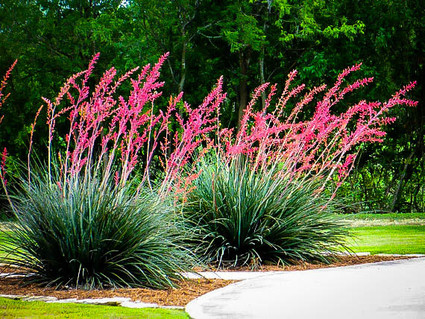Say Howdy to This Plant from the Wild West UT Gardens' July 2020 Plant of the Month
July 9, 2020
Submitted by Carol Reese,
UT Extension Western Region Horticulturist
Some plants feature beautiful flowers, others have interesting foliage, and still others are known for their strong architectural form. Hesperaloe parviflora provides all three.
This plant is called a number of common names that include red yucca, coral yucca, false red yucca, and Texas red yucca; however, it is not a yucca at all. Other valid reasons to avoid using this plant's common names are that yellow-flowering cultivars can be found, but the best reason is that the accurate name is truly easy to pronounce. Just substitute the consonants and make it rhyme with "desperado." In fact, I suffer with the "ear worm" of the Eagles' song that goes by that name whenever I look at this plant!
Hesperaloe parviflora is native to west Texas and northeastern Mexico, so you can imagine that it is quite heat and drought tolerant. Many plants from these arid regions cannot tolerate the humidity and denser soils of the southeastern United States, but hesperaloe has done so admirably. Obviously, plant it in soils with good drainage and be aware that it flowers best with lots of hot sunlight, although it is surprisingly tolerant of a few hours of shade.
Hummingbirds eagerly seek out the multiple small coral red flowers that stud the branching panicles, conveniently launched high on flowering stems over the foliage. Flowering can continue throughout the summer months, and over the years, this durable plant will slowly broaden, adding several more flowering stems to make quite a show. Expect some variability in flowering due to clonal differences and variations on siting. Weather may also play roles.
There is little reason to lament the end of the flowering period. Hesperaloe's appealing icy blue foliage springs from a central base as a yucca would, but the long curving leaves are rigid and narrow, and "prickle free". It doesn't form trunks, but grows wider and more densely each year until it takes on the appearance of a large, stiff grass. Use it as a component of winter interest in the landscape, where it pairs handsomely with conifers, or even in winter containers as a sculptural statement.
In the ground, a well-established hesperaloe should be hardy throughout all of Tennessee, and some sites rate it hardy to zone 5 as long as roots are not in too much moisture. Be aware that dry soils in summer are not always so in winter, so site accordingly.
The UT Gardens, Jackson, has hesperaloe displayed in the parking lot beds northeast of the building. At the UT Gardens, Knoxville, look for it along the perennial walk as you head to the rose garden.
The UT Gardens includes plant collections located in Knoxville, Crossville and Jackson. Designated as the official botanical garden for the State of Tennessee, the collections are part of the UT Institute of Agriculture. The Gardens' mission is to foster appreciation, education and stewardship of plants through garden displays, educational programs and research trials. The Gardens are open during all seasons and free to the public. For more information, see the Gardens website: utia.tennessee.edu/state-botanical-garden.




Reader Comments(0)